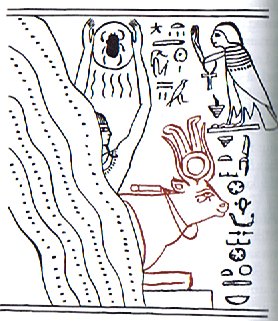Towards the end of the dark and unlucky 4th quarter 'fire' was once brought about by whips of goat-skin snapped like long slender fingers at the backs of the ladies, which possibly explains the strange quartet with 'feathers' on their backs:
12 + 13 = 25 and 15 + 15 = 30. Allen: "... Hyginus of Micyllus, in 1535, has the Driver in a two-wheeled cart with a pair of horses and a yoke of oxen all abreast ..." The beasts in the 1st pair of glyphs (Gb6-21--22) are indeed different from those in the 2nd pair - they have their 'upper beaks' pointing up in contrast to those in the 2nd pair which have their pointing down. Horses come earlier than oxen - the first Hindu moon station is Ashvini, the Horsemen, ruled by β and γ Arietis (Sheratan respectively Mesarthim).
July 1 is Gregorian day 182 and from there to April 17 there are 365 + 107 - 182 = 290 days. And 107 is the elusive difference between the number of days in the G text and the number of days in a year. The blind moa in Gb5-19 regains his sight in Gb7-1, but on othe other hand the tip of his upper beak is lost:
There are 40 days from Gb5-18 at the joint to moa in Gb7-1. Or better, there are 6 weeks from Gb5-18 to the Janus-eyed hau tea in Gb7-2. The blind moa is behind and the living moa in front. There seems to be a mirror between Pleione 1 and Heka 1. 412 - 373 = 39 and this mirror should be at glyph number 373 + 38 / 2 = 392, presumably alluding to Polaris and the Horsemen. Glyph 392 is at the end of the 5th right ascension hour, in 'June 19 where the tagata has 3 hairs on top of his head:
Tamaiti at Gb7-3 probably indicates where next great fortnight is beginning. 14 * 29½ + 1 = 414. In Gb7-4 'the old one' apparently is depicted as 'dead' (with closed eyes, mata). Castor was the twin who died, and there are no mata at this hau tea. 'July 12 is 3 weeks after 'June 21. My early endeavours to count the glyphs on the K tablet resulted in the estimate 192. This number can be regarded as equal to 8 * 24. We who are used to 10 as the number base must try to think also in terms of 8 as a number base. For instance can we count with 8 * 59 glyphs in the G text. With an octal instead of a decimal system we can write the probable number of glyph spaces on the K tablet as 300, because 24 should be written as 30 and 8 as 10. The idea to count 300 days for Sun possibly originates from the octal script 3008 for 192. A new Sun season appears to originate from Markab (κ Puppis) far down in the Milky Way, where the great sunken Argo ship is beginning:
The front side of henua in Gb7-6 is longer than the back side.
... Men's spirits were thought to dwell in the Milky Way between incarnations. This conception has been handed down as an Orphic and Pythagorean tradition fitting into the frame of the migration of the soul. Macrobius, who has provided the broadest report on the matter, has it that souls ascend by way of Capricorn, and then, in order to be reborn, descend again through the 'Gate of Cancer'. Macrobius talks of signs; the constellations rising at the solstices in his time (and still in ours) were Gemini and Sagittarius: the 'Gate of Cancer' means Gemini. In fact, he states explicitly (I,12.5) that this 'Gate' is 'where the Zodiac and the Milky Way intersect'. Far away, the Mangaians of old (Austral Islands, Polynesia), who kept the precessional clock running instead of switching over to 'signs', claim that only at the evening of the solstitial days can spirits enter heaven, the inhabitants of the northern parts of the island at one solstice, the dwellers in the south at the other ...
Hau tea standing very straight in Gb7-14 is at a π position in the Gregorian calendar. Alhena is a name for γ Gemini, see above at Gb6-23. Tegmine is ζ Cancri.
Perhaps the creator of the G text draw similar glyphs at Heap of Fuel (μ Cancri) and Bright Fire (λ Cancri) because these star names seem to belong together. The general design is the same as that at Antares, also a star connected with 'ignition' (because it marked the return of summer south of the equator). Yes, we can guess the curved tail of mago illustrates how a 'fish' ('land') is drawn up from the deep. Possibly this idea can also help us to explain the curious Ga1-1:
The straight tail of the Aldebaran (Ana-muri) fish denies 'land in the light from Sun', because south of the equator this is the end (muri) of the summer half of the year. I think the Taurus constellation in ancient Egypt was thought of as the Hathor cow (Egyptians saw everything 'upside down') was emerging from the waters of winter:
The horns of the Taurus bull could be at front in Ga1-1 (and also alluded to in Ga1-4). Instead of a curved fish tail at front bottom (indicating 'Sea') there is curve leading to a henua ('Land') sign at top left indicating how south of the equator summer is ending.
Vaha mea at Gb7-25 corresponds to day 214 in the Gregorian calendar and therefore its day 400 should be 186 glyphs later (the tresses of Pachamama gives the equation 214.5 + 185.5 = 400). 436 + 186 - 365 = 257:
136 days after equinox is the day before 9h, coinciding with the beginning of the Murzim manzil (ruled by Sirius):
|






.jpg)
.jpg)














